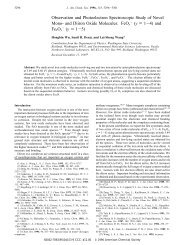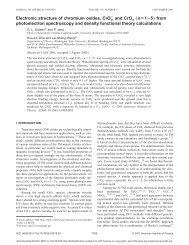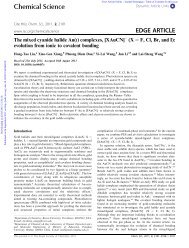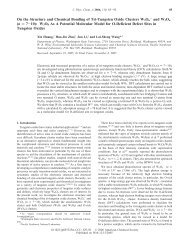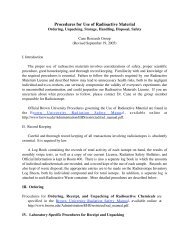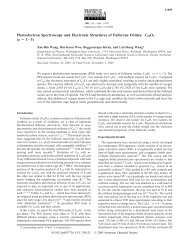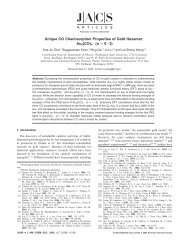A study of the structure and bonding of small aluminum oxide ...
A study of the structure and bonding of small aluminum oxide ...
A study of the structure and bonding of small aluminum oxide ...
You also want an ePaper? Increase the reach of your titles
YUMPU automatically turns print PDFs into web optimized ePapers that Google loves.
Desai et al.: Aluminum <strong>oxide</strong> clusters<br />
1315<br />
experiments suggested that an unsymmetrical, C 1 , isomer<br />
<strong>and</strong> <strong>the</strong> symmetric linear OAlOAlO, D h , molecule were<br />
observed. 13 Although <strong>the</strong> previous calculations indicated a<br />
planar C 2v <strong>structure</strong> to be very close in energy to <strong>the</strong> linear<br />
<strong>structure</strong>, <strong>the</strong>y found that <strong>the</strong> lowest energy <strong>structure</strong> on <strong>the</strong><br />
singlet potential surface is <strong>the</strong> linear, D h species. 58,72 However,<br />
our calculations have also found <strong>the</strong> C 2v rhombus<br />
<strong>structure</strong> to be a true minimum. These are shown schematically<br />
in Fig. 4.<br />
In Fig. 3b <strong>the</strong> broad vibrational progression in <strong>the</strong><br />
ground state <strong>of</strong> Al 2 O 3 implies that <strong>the</strong>re is a significant<br />
change in <strong>the</strong> geometry between <strong>the</strong> anion <strong>and</strong> <strong>the</strong> neutral.<br />
Also, this progression is very similar to that <strong>of</strong> Al 2 O 4 <strong>and</strong><br />
Al 2 O 5 see below. It is expected that, for <strong>the</strong> C 2v rhombus,<br />
Fig. 4c <strong>structure</strong>, <strong>the</strong> extra electron in <strong>the</strong> anion would be<br />
located on <strong>the</strong> terminal <strong>aluminum</strong> atom that is attached to<br />
three oxygen atoms. Therefore, <strong>the</strong> broad vibrational progression<br />
in <strong>the</strong> ground state is consistent with <strong>the</strong> removal <strong>of</strong><br />
an electron from a <strong>bonding</strong> orbital, presumably Al sp in<br />
character. The enhancement in <strong>the</strong> intensity <strong>of</strong> <strong>the</strong> ground<br />
state <strong>of</strong> Al 2 O 3 , at 6.42 eV photon energy, indicates that it<br />
results from <strong>the</strong> removal <strong>of</strong> an Al -type electron. This reasoning<br />
is based on <strong>the</strong> observation that for high angular momentum<br />
initial states, photoemission cross sections generally<br />
increase as <strong>the</strong> photon energy increases. 73 Such cross section<br />
dependence on photon energies has been observed in photodetachment<br />
experiments <strong>of</strong> <strong>the</strong> 4s <strong>and</strong> 3d electrons <strong>of</strong> Cu <br />
anion 74 <strong>and</strong> transition metal clusters. 75 The sharp peak at<br />
higher BE 4.32 eV is consistent with <strong>the</strong> removal <strong>of</strong> an<br />
electron from a non<strong>bonding</strong> orbital. This state is probably a<br />
result <strong>of</strong> <strong>the</strong> removal <strong>of</strong> an electron from <strong>the</strong> <strong>aluminum</strong> atom<br />
that is bonded to only two oxygen atoms. The nature <strong>of</strong> <strong>the</strong><br />
first excited state in Al 2 O 3 is probably similar to that <strong>of</strong> <strong>the</strong><br />
ground <strong>and</strong> excited states <strong>of</strong> Al 2 O 2 , both <strong>of</strong> which are also<br />
results <strong>of</strong> <strong>the</strong> removal <strong>of</strong> non<strong>bonding</strong> electrons on Al atoms<br />
bonded to two O atoms. The third peak at about 4.9 eV<br />
belongs to <strong>the</strong> second excited state <strong>of</strong> Al 2 O 3 <strong>and</strong> is presumably<br />
from a <strong>bonding</strong> orbital <strong>of</strong> oxygen 2p character.<br />
Our calculations, at both <strong>the</strong> HF <strong>and</strong> MP2 levels, found a<br />
true minimum for <strong>the</strong> rhombus (C 2v ) species depicted in<br />
Fig. 4c. We obtain a scaled, totally symmetric vibrational<br />
frequency <strong>of</strong> 888 cm 1 at <strong>the</strong> HF level <strong>of</strong> <strong>the</strong>ory, <strong>and</strong> a<br />
scaled frequency <strong>of</strong> 804 cm 1 at <strong>the</strong> MP2 level, in excellent<br />
agreement with <strong>the</strong> experimentally observed value. Fur<strong>the</strong>rmore,<br />
<strong>the</strong> similarity among <strong>the</strong> PES spectra <strong>of</strong> Al 2 O <br />
3 ,Al 2 O 4<br />
see below <strong>and</strong> Al 2 O 5 see below <strong>and</strong> <strong>the</strong> vibrational frequencies<br />
<strong>of</strong> <strong>the</strong> ground states lends support to <strong>the</strong> assignment<br />
<strong>of</strong> a rhombus C 2v , Fig. 4c <strong>structure</strong> to <strong>the</strong> species observed<br />
in our experiment.<br />
O<strong>the</strong>r isomers with higher energies were also considered<br />
in our calculations at <strong>the</strong> HF <strong>and</strong> MP2 levels. A minimum<br />
was found for ano<strong>the</strong>r planar C 2v species Fig. 4d, which<br />
can be described as an Al-O-Al unit with two oxygen atoms<br />
added to one <strong>aluminum</strong>. Also, <strong>the</strong> linear molecule Fig. 4b<br />
was found to be a true minimum at both <strong>the</strong> HF <strong>and</strong> MP2<br />
levels. It is expected that <strong>the</strong> electron affinities <strong>of</strong> <strong>the</strong> linear<br />
<strong>and</strong> C 2v molecules would be significantly different <strong>and</strong> calculations<br />
to determine this value may help provide ano<strong>the</strong>r<br />
piece <strong>of</strong> information to differentiate among <strong>the</strong>se isomers.<br />
E. Al 2 O 4<br />
<br />
Figures 3a <strong>and</strong> 3b show <strong>the</strong> PES spectra <strong>of</strong> Al 2 O 4 at<br />
266 <strong>and</strong> 193 nm, respectively. Both <strong>the</strong> 266 <strong>and</strong> 193 nm<br />
spectra show a broad, vibrationally resolved b<strong>and</strong> at lower<br />
BE. Two well resolved hot b<strong>and</strong> features are observed in <strong>the</strong><br />
266 nm spectrum yielding a vibrational frequency <strong>of</strong> 1090<br />
60 cm 1 for <strong>the</strong> anion Table II. The spectrum at 193 nm<br />
reveals an additional b<strong>and</strong> at higher BE which is broad <strong>and</strong><br />
not well defined. The first b<strong>and</strong> corresponds to <strong>the</strong> ground<br />
state (X) <strong>of</strong> <strong>the</strong> neutral molecule with an EA <strong>of</strong> 3.98 eV. The<br />
second b<strong>and</strong> corresponds to <strong>the</strong> first excited state (A) <strong>of</strong> <strong>the</strong><br />
neutral molecule <strong>and</strong> occurs at about 5.1 eV.<br />
The presence <strong>of</strong> Al 2 O 4 was suggested in previous matrix<br />
isolation experiments. 13 Previous calculations indicated that<br />
<strong>the</strong> molecule is a complex <strong>of</strong> two AlO 2 molecules which are<br />
twisted with respect to each o<strong>the</strong>r to give a C 2v symmetry. 64<br />
However, our preliminary calculations for this molecule indicate<br />
that <strong>the</strong> symmetric D 2h Al 2 O 4 is also a true minimum.<br />
This <strong>structure</strong> is shown schematically in Fig. 4e, along with<br />
<strong>the</strong> C 2v <strong>structure</strong> Fig. 4f.<br />
The ground state <strong>of</strong> <strong>the</strong> neutral molecule is characterized<br />
by a vibrational progression with a frequency <strong>of</strong> 930 60<br />
cm 1 <strong>and</strong> an electron affinity <strong>of</strong> 3.98 eV. Upon formation <strong>of</strong><br />
<strong>the</strong> anion, it is expected that, for <strong>the</strong> D 2h molecule, <strong>the</strong> extra<br />
electron will be localized on an <strong>aluminum</strong> atom because <strong>the</strong><br />
Al atoms are expected to possess significant positive charges<br />
as a result <strong>of</strong> strong electron transfer between <strong>aluminum</strong> <strong>and</strong><br />
oxygen. Therefore, we suspect that <strong>the</strong> ground state vibrational<br />
progression is a result <strong>of</strong> removing an electron from a<br />
<strong>bonding</strong> orbital localized on <strong>the</strong> <strong>aluminum</strong> atoms.<br />
The second peak at approximately 5.1 eV corresponds to<br />
<strong>the</strong> first excited state <strong>of</strong> Al 2 O 4 . This state is probably due to<br />
<strong>the</strong> removal <strong>of</strong> a more tightly bound O 2p electron from <strong>the</strong><br />
bridging oxygen atoms. Although previous calculations have<br />
suggested <strong>the</strong> C 2v ‘‘twisted pair’’ <strong>structure</strong>, it seems to make<br />
more chemical sense for <strong>the</strong> two nonbridging oxygen atoms<br />
to bind to each <strong>of</strong> <strong>the</strong> <strong>aluminum</strong> atoms to form <strong>the</strong> D 2h<br />
species. In <strong>the</strong> C 2v ‘‘twisted pair’’ <strong>structure</strong>, one set <strong>of</strong> bonds<br />
between <strong>the</strong> bridging oxygens <strong>and</strong> <strong>the</strong> tetrahedrally bonded<br />
<strong>aluminum</strong> atom are very long <strong>and</strong> are, <strong>the</strong>refore, expected to<br />
be relatively weak.<br />
In our preliminary calculations, a true minimum was obtained<br />
at both <strong>the</strong> HF <strong>and</strong> <strong>the</strong> MP2 levels for <strong>the</strong> symmetric<br />
D 2h species. The highest A g vibrational frequency calculated<br />
for this molecule is 932 cm 1 at <strong>the</strong> scaled HF level, which<br />
is in excellent agreement with <strong>the</strong> experimentally obtained<br />
value. However, at <strong>the</strong> MP2 level, <strong>the</strong> Al–O bonds are considerably<br />
leng<strong>the</strong>ned. Based on <strong>the</strong> agreement <strong>of</strong> <strong>the</strong> vibrational<br />
frequency HF <strong>and</strong> <strong>the</strong> similarity <strong>of</strong> <strong>the</strong> electronic <strong>and</strong><br />
vibrational <strong>structure</strong> among Al 2 O 3 ,Al 2 O 4 , <strong>and</strong> Al 2 O 5 see<br />
below, we suggest <strong>the</strong> D 2h species Fig. 4e as a c<strong>and</strong>idate<br />
for Al 2 O 4 . It is expected that Al 2 O 4 would be made by taking<br />
a C 2v Fig. 4c Al 2 O 3 molecule <strong>and</strong> adding an oxygen atom<br />
J. Chem. Phys., Vol. 106, No. 4, 22 January 1997<br />
Downloaded¬26¬Jun¬2007¬to¬130.20.226.164.¬Redistribution¬subject¬to¬AIP¬license¬or¬copyright,¬see¬http://jcp.aip.org/jcp/copyright.jsp



